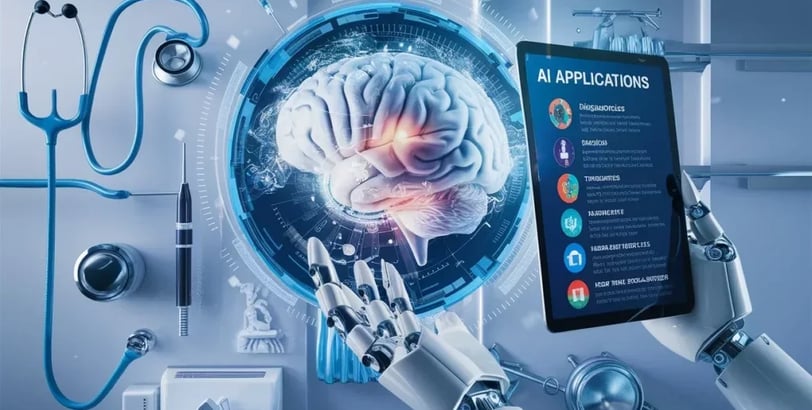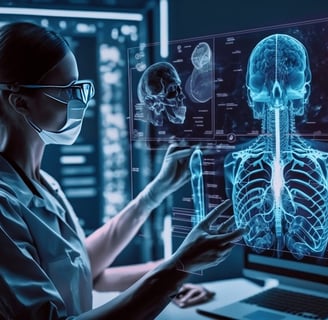How AI and Machine Learning are Shaping the Future of X-ray Imaging
X-ray imaging has been a vital tool in medicine for over a century, helping doctors diagnose fractures, lung infections, and even cancers. However, as healthcare becomes more advanced, traditional X-ray imaging is evolving to incorporate cutting-edge technologies like Artificial Intelligence (AI) and Machine Learning (ML). These technologies are bringing significant improvements to how X-ray images are analyzed, interpreted, and used in medical practice. In this blog, we’ll dive into the many ways AI and ML are transforming X-ray imaging, improving diagnostic accuracy, and making healthcare more efficient and accessible.
3/24/20253 min read


1. AI and Machine Learning: A Brief Overview
Before we explore their impact on X-ray imaging, let’s briefly define AI and ML:
Artificial Intelligence (AI) refers to machines or software that perform tasks that would usually require human intelligence, such as reasoning, problem-solving, and decision-making.
Machine Learning (ML), a subset of AI, is a technique where algorithms learn from large datasets to improve their performance over time. When it comes to X-ray imaging, ML algorithms are trained on millions of X-ray images, learning to identify patterns, detect anomalies, and make predictions.
2. Enhancing X-ray Diagnostic Accuracy
Traditional X-ray interpretation relies on radiologists, who are trained to analyze the images for signs of disease. However, human interpretation is not always perfect, and sometimes, important details can be overlooked. This is where AI and ML come into play.
AI systems can assist radiologists by analyzing X-ray images at a much faster rate, and with high accuracy. For instance, AI can:
Identify early signs of diseases such as lung cancer, osteoporosis, and tuberculosis that might be invisible to the naked eye.
Detect fractures and abnormalities more accurately, ensuring quicker and more reliable diagnoses.
Reduce human error by flagging areas of concern on the images that might require further examination, providing a “second opinion” that helps prevent missed diagnoses.
3. Speeding Up the Diagnostic Process
The ability to analyze X-ray images quickly is one of the major advantages of AI. Radiologists often face immense workloads, with thousands of images to interpret each day. AI speeds up this process by automatically identifying and classifying abnormalities in X-rays, allowing radiologists to prioritize urgent cases and focus on complex scenarios.
AI can:
Prioritize critical cases, ensuring that patients with life-threatening conditions like fractures or lung infections receive immediate attention.
Automate routine tasks, such as measuring the size of a tumor or identifying bone fractures, giving radiologists more time to interpret complex cases.
4. AI and Image Quality Enhancement
X-ray images can sometimes be affected by noise, motion blur, or low resolution, making it difficult to detect small but significant issues. AI-driven image enhancement tools can improve the quality of these images, allowing for a more accurate diagnosis.
Some AI capabilities include:
Noise Reduction: AI can remove unwanted noise from X-ray images, enhancing clarity and improving the visibility of subtle details like small fractures.
Image Reconstruction: AI can reconstruct parts of an image that might be unclear due to patient movement or equipment limitations, providing a clearer and more reliable image for diagnosis.
5. AI in Early Disease Detection and Screening
One of the most powerful uses of AI in X-ray imaging is its ability to detect diseases in their early stages, when they are easier to treat. Early detection through X-ray imaging can make a huge difference in patient outcomes, particularly in diseases such as:
Lung cancer: AI can analyze chest X-rays to detect small nodules or masses that could indicate the presence of lung cancer. Early identification improves the chances of successful treatment.
Tuberculosis (TB): In regions where TB is common, AI-powered systems can scan chest X-rays for signs of the disease, helping healthcare providers catch the infection in its earliest stages.
Osteoporosis: AI can identify signs of bone loss in X-rays, enabling earlier intervention and management of this condition.
6. Reducing Healthcare Costs with AI-Powered X-rays
Healthcare costs are a significant concern worldwide. The integration of AI in X-ray imaging can help reduce costs in several ways:
Faster diagnoses: By automating the interpretation of routine X-ray images, AI helps radiologists focus on more complex cases. This improves efficiency, allowing for quicker diagnoses and reducing wait times for patients.
Remote diagnosis: AI tools enable healthcare providers to interpret X-rays in remote or underserved areas, where radiologists might not be readily available. This increases accessibility to healthcare services in regions that might otherwise struggle to offer timely diagnoses.
7. The Future of AI in X-ray Imaging
AI and ML in X-ray imaging are still evolving, and their potential is just beginning to be realized. As technology improves, we can expect even more advancements, including:
Predictive Diagnostics: AI could soon be able to predict a patient’s likelihood of developing certain conditions based on their X-ray images and medical history. This could help doctors take preventive measures before a disease progresses.
Integration with Other Imaging Modalities: AI is increasingly being integrated with other imaging technologies, such as CT scans and MRI. In the future, AI could analyze data across multiple modalities, offering a more complete picture of a patient’s health.
Personalized Medicine: With AI, X-ray imaging could be used not just for diagnosis but also for tailoring personalized treatment plans. AI can analyze how a patient’s condition is likely to progress and suggest the most effective treatment options.


Reference Website Links:
Innovative
Contact Us
Service
xraybazar.com
© 2024. All rights reserved.
Address- Rajasthan, India
Gmail Id- xraybazaroffcial.com
Important Links
